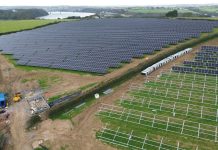Britain’s backbone network operator has published its expansion blueprint, designed to extend by 86GW the nation’s transmission capacity in the run up to 2035.
The National Grid-ESO’s plans, costed in its ‘Beyond 2030’ manifesto at £58 Billion over the coming decade, are the biggest transformation of country-spanning transmission & distribution grids since they first emerged in the 1950s.
Carrying new wind-generated power from marine farms concentrated off the east coast to urban centres of heaviest demand requires delivering an ‘electrical spine’, running from landing points in Aberdeenshire down to demand hot spots in England’s North West, the report outlines.
Three quarters of the new grid investment will be made at sea, the document discloses. Three new subsea links to North Sea wind farms, including Hornsea 3, the world’s largest at 2.9GW, will be built, the operator intends.
But new pylons and transformers onshore threatening rural views look likeliest to spur resistance from objectors.
Heavyweight grid upgrades & extensions are seen as essential if the UK is to bring online the 50GW of offshore wind capacity the government is targeting by 2030, en route to delivering on its goal of a fully decarbonised grid by 2035.
The projected £58 billion tag is a quantum leap beyond the £9 billion the National Grid currently budgets now in its Great Grid Upgrade. That programme is tasked to remove existing transmission bottlenecks over the next two years.
The ESO needs to take ‘swift, co-ordinated & lasting action” if Britain is to meet its longer term decarbonisation goals, the body’s executive director Fintan Slye told the Sunday Times at the weekend.
Accommodating new capacity from offshore wind, interconnectors, and nuclear power will all generate more electricity than the networks are currently able to transport, the National Grid said.
Regional imbalances dot the nation’s infrastructure. Scotland, famously ‘the Saudi Arabia of wind power’, generates at present around 15GW, but uses no more than 5GW even on winter’s coldest days.
Endorsing the plans, a National Grid statement hailed them as recognising the need for networks to be delivered at pace, “unlocking a more affordable and resilient decarbonised electricity system in the UK”.
“We now look forward to working with the System Operator, with government and with Ofgem on the further development needed to progress these reinforcements”, a Grid spokesperson added, “and to move towards creating a Strategic Spatial Energy Plan, coupled with a consentable Centralised Strategic Network Plan.
“That will sets out what energy infrastructure needs to be built, where and when, to deliver a capacity-rich, future-ready network that will serve society and underpin economic growth,” the Grid’s statement noted.
The plans will now receive comment from industry stakeholders and Ofgem. Network operators and generators will develop work up through recommendations further through a Detailed Network Design Phase.
The process involves testing alternative on- and offshore answers, further developing cable routing and technology choices.
Industry stakeholders welcomed the ESO’s intentions. From analysts Cornwall Insight, Tom Faulkner commented: “The ESO lays out the essential grid investments required to keep pace with the escalating electricity demand
“The 2035 forecasts for wind and solar capacity outlined in the report are notably ambitious compared to Cornwall’s current estimates”, Faulkner went on. “Achieving these targets will demand substantial investment, not only in grid infrastructure but also in the renewable generation assets themselves.
From pro-growth campaigners Britain Remade, founder Sam Richards observed: “If Britain wants an abundant supply of secure domestic energy that cannot be used as an economic weapon by autocratic regimes, then we need to continue to invest in offshore wind and the critical infrastructure needed to move the energy around the country.
“Investing in clean energy is not just good for the environment, it’s good for the economy. From Aberdeen to Teesside and Ramsgate the offshore wind industry has already created tens of thousands of well-paid jobs with even more to come”.
Reforms to ‘Britain’s glacial planning system’ were essential though to slash delays in permitting offshore wind farms built”, Richards added
“It’s mind boggling that it can take up to 13 years to build an offshore wind farm despite construction of the actual turbines only taking two years”.
Read NG-ESO’s ‘Beyond 2030’ in full here.




